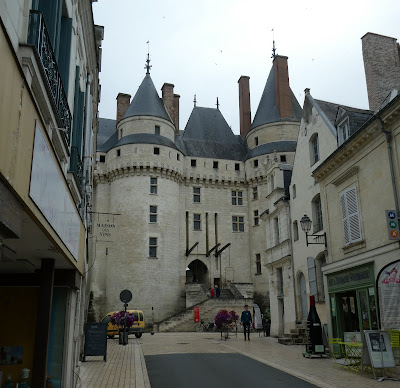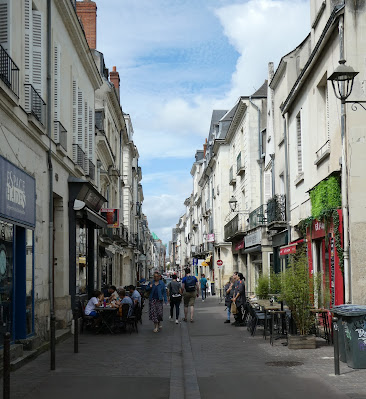In all of our many trips to France, neither Lon or I had ever travelled to the Loire River Valley to experience "chateau culture." It would have been a shame had we failed to do so this year, given that we were going to be cruising on the Canal lateral a la Loire.
The Loire River, called "the last wild river in Europe" because it has never been canalized, separates northern France from southern France. In WWII, Occupied France was north of the Loire; "Free" France (Vichy) was south of the Loire. Several centuries earlier, during the Hundred Years' War, the English occupied the territory north of the Loire and the French were to the south.
Fortress-like castles had been built in the Loire Valley from the 10th century onwards. After the English were gone from France in the late 15th century, the Italian Renaissance influence began to be felt and the Loire Valley became the "upscale neighborhood" for castles that were less warlike and more pleasure palace for French royalty and their noble underlings. UNESCO recognizes an approximately 175-mile-long stretch of the Loire as a culturally important site. The number of castles? I've seen approximations of 300 bandied about, but how many there were--and how many there currently are--is not easy to figure out.
We arrived in Nevers on Saturday, July 6, and celebrated our 45th wedding anniversary on Sunday, July 7th, with lunch during a walking tour of the town. (More on that later.) Our focus then turned to chateaux.
For flexibility, we rented a car in Nevers on July 8 for the 220+ km drive to the city of Tours, which would be our base until July 12. Lon had quite a workout with the manual transmission on the secondary roads we took--shifting was frequent due to the numerous speed changes necessitated by towns, villages, and traffic circles. We also experienced a fun bit of serendipity. While the Tour de France cyclists were taking July 8 as a rest day in the city of Orleans, we were surprised to find ourselves driving on a portion of the D976 that would be included in the Stage 10 route on July 9. Good timing on our part!
The "slow route" took about 3.5 hours of driving, not including stops. When we were about 40 minutes from Tours, we drove through the village of Chenonceau, the site of a chateau we wanted to visit during our trip. We thought it might be a useful break to do the visit at this time--but that thought lasted about 5 seconds. The mid-afternoon crush of people, cars, and tour buses that we saw in the parking lot quickly disabused us of that notion. Suddenly, a first-thing-in-the-morning stop on Friday during our return to Nevers seemed a lot smarter.
Our airbnb apartment in Tours turned out to be just "OK", but it was within walking distance of the old town, and it had a big plus:
 |
| According to the airbnb host, Sancy the Siamese cat is the real owner of the apartment. He was a lovebug, and I would never turn down the chance for a lap cat. |
To avoid driving fatigue and FCOS--French Chateau Overload Syndrome--we set some parameters for choosing the castles we'd visit: (1) drives to chateaux on Tuesday and Thursday, with a rest-from-driving day on Wednesday to be spent walking around Tours; (2) no more than 2 chateau visits per day; and (3) chateaux must be no more than a 30–45-minute drive from our airbnb.
First up on July 9--Chateau d'Azay-le-Rideau, a small, but mighty example of early French Renaissance architecture. Construction began in 1518, and subsequent renovations achieved the current appearance of the chateau by the mid-19th century.
 |
| The chateau seems to serenely float on the Indre River. |
Chateau d'Azay-le-Rideau was never a residence of kings, although it did have a "Louis XIII slept here for 2 nights in 1619" moment. It was owned by a series of nobles, including the several generations of Marquis de Biencourt (who invested much in preserving and developing the castle), before passing into the hands of the French government in 1905.
 |
| The rooms on one floor were furnished as they might have been in the 19th century--but the fireplace is all Renaissance. |
 |
| The timbers in the attic are those from the original construction in the early 16th century. The attic is also a sanctuary for about 50 Greater Mouse- eared Bats. |
 |
| The land approach to the chateau, and a hint of the gardens that surround it. |
We switched stylistic gears with our afternoon visit to Chateau Langeais, a mere 20 minutes from Azay-le-Rideau.
 |
| Crossing the 19th C. suspension bridge over the Loire to reach Langeais. |
 |
| On the garden side, we start to see some window frills that are harbingers of the Renaissance. |
 |
| The city side presents an austere, medieval face, complete with a drawbridge that must be crossed for entry, and internal parapets (that can be walked) for defense. |
 |
| Dining (top) and a bedroom (bottom). Bedrooms were used in those days for both sleeping and for greeting guests. |
 |
| View over the town of Langeais from the castle parapet. We had time after the castle visit for a walk through the town: cute, clean, and--of course--in possession of an old, old church. |
Our "off" day on Wednesday, July 10, didn't involve any driving, but it was anything but "off" overall. We must have walked at least 6 miles in our circuit around the sights of Tours.
 |
| Part of the 4th C. Gallo-Roman fortifications. When built, it split in two the site where an amphitheater had existed. |
 |
| Saint-Gatien's Cathedral |
 |
| All that remains of the Chateau de Tours is two towers. The towers were later incorporated into what is now a center for photographic expositions. |
 |
| The convention center definitely does not evoke the past. |
 |
| The beautiful 19th century train station. |
 |
| The old Archbishop's Palace, now a museum of fine arts. |
 |
| Place Plumereau and its timbered buildings in the old city. |
 |
| Basilica Saint-Martin, a 19th century tribute to Saint Martin of Tours, a Bishop of Tours in the 4th century, and a major patron saint of the Catholic Church. |
 |
| Saint-Martin's tomb in the crypt of the Basilica. The lower portion of the tomb is said to contain a relic of Saint Martin. |
 |
| Rue Colbert, the main medieval street of Tours. |
We had hoped for an evening sound and light show on the facade of the cathedral, a common event during summer in other French towns, but we were disappointed. The city previously put on such a display, but discontinued it during COVID and never started it up again. That's OK, after the extensive walking during the day, a night in the apartment with feet up felt good.
.jpg)



No comments:
Post a Comment